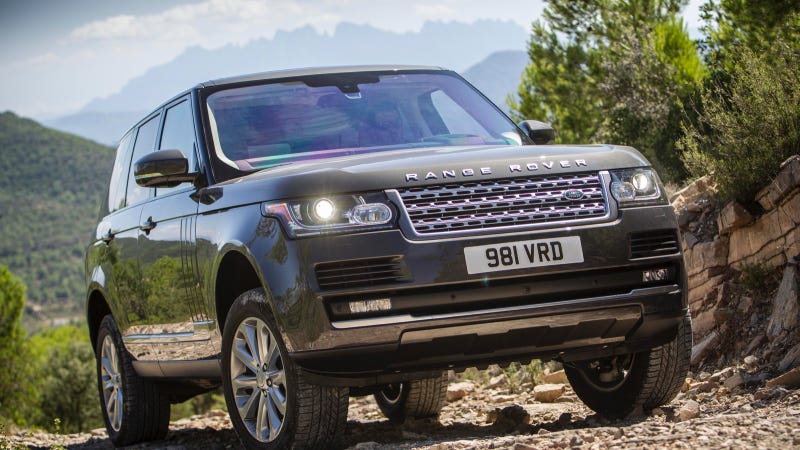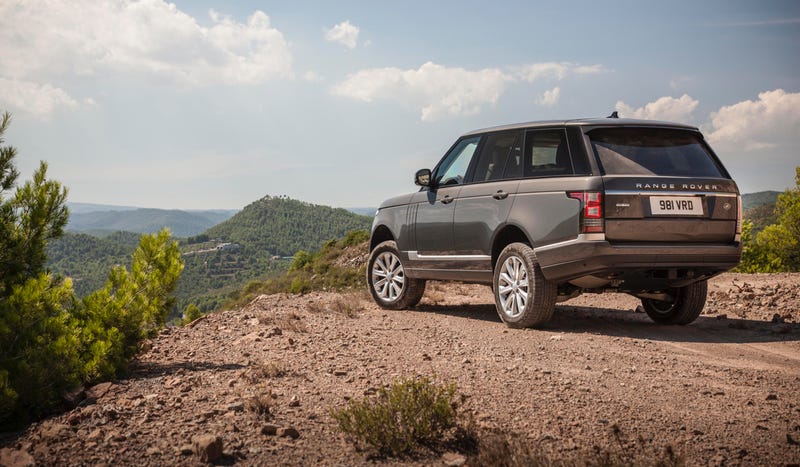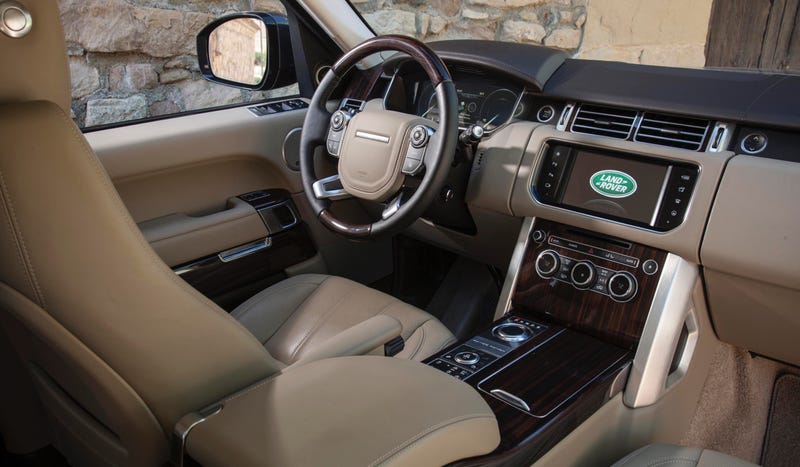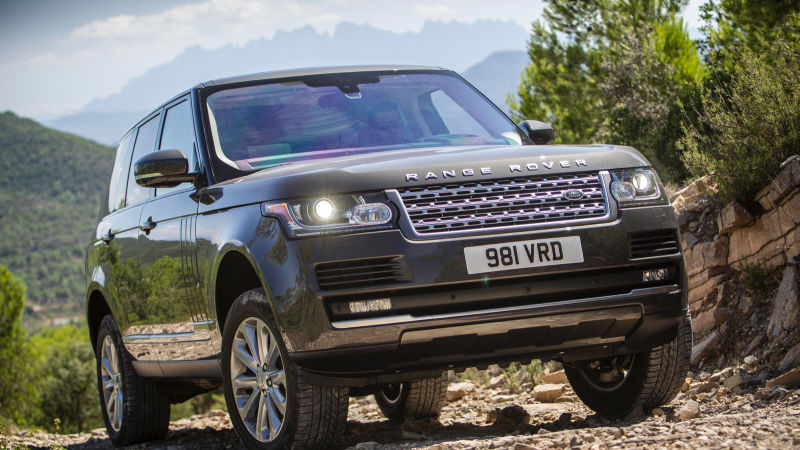
Put simply, the current Range Rover is the best SUV in the world. It can go anywhere, it can do so very quickly, and it can do so while offering you and your passengers the utmost level of comfort and luxury. What do you need to know before you buy a Ranger Rover? Don’t worry, we’ll tell you everything right here in the Ultimate Buyer’s Guide.
Today’s Range Rover is a far cry from the brutal, utilitarian farm trucks they started out as. But that’s not a bad thing for you, the luxury SUV buyer! Opting into a Range Rover still means getting one of the most ridiculously capable vehicles for any kind of weather or terrain.
Granted, most modern Range Rovers seem more at home at Neiman-Marcus parking lots than the trail, but that shouldn’t count as a strike against the vehicle itself. Buy a Range Rover. Take it to the ends of the earth as well as the mall. Do the right thing.
Advertisement
What It’s Like To Drive
Many of the traits we think of when we think “SUV” owe their existence to the Range Rover, from the high seating position to the luxuriously appointed interior.
While each successive generation of Range Rover has offered more power, capability, and comfort, there’s a cohesive set of expectations you can bring into any of the cars. It will be plush, sure, but also capable and easy to drive.
Sponsored
Modern Range Rovers have supercharged V6 and V8 engines and both happen to provide abundant acceleration—some options more than others. Despite their size they’re surprisingly maneuverable, with light, accurate steering and a ride that’s never uncomfortable or overly truck-like.
In addition to good on-road manners, Range Rovers are equipped with a Terrain Response system that allows the driver to customize the SUV’s behavior depending on what’s under the tires, as well as more off-road goodies like hill descent and ride height control. The Range Rover’s plush image belies its extreme competence.
What’s New About The 2016 Range Rover

Like we mentioned in our Range Rover history lesson, the fourth generation Range Rover made its first appearance at the 2012 Paris Motor Show. The big news for the new Range Rover was its ridiculous 700 pound weight-loss thanks to an industry-first for SUVS: an all-aluminum unibody. Aside from the steady diet of SlimFast, the Range Rover got bigger, giving the rear passengers an additional 4.7-inches of legroom.
Of course, the Range Rover also got a makeover for 2013. The exterior styling is a bit less “bling bling” than the outgoing model and the interior is all-new.
On the powertrain front, the new fourth gen launched in the U.S. with a pair of 5.0-liter V8s: one supercharged and one naturally aspirated. The new model also got an updated Terrain Response 2 system, a refined new air suspension and the eight-speed ZF automatic transmission.
The second year for Land Rover’s flagship brought a more efficient 3.0-liter supercharged V6 to replace the thirsty naturally aspirated 5.0-liter V8. Also new for 2014 was the addition of Start-Stop technology to the supercharged V8, standard LED headlights, and more shuffling of standard features and option packages.
The ‘15 Range Rover gets some new 10-way power front seats to replace the eight-way seats from ‘13 and ‘14. The Ranger Rover also adds a new long-wheelbase HSE trim. There’s a new Driver Assistance Pack option, and there have been a few other changes made to optional and standard equipment.
For 2016, the Range Rover HSE’s 3.0-liter supercharged V6 grows by 40 horsepower, bringing it to a total of 380. But if you want the torques, you’ll want the all-new 3.0-liter diesel V6, which promises 25 MPG combined and makes 443 lb-ft of twist.
Also new for 2016, All-Terrain Progress Control–basically a low-speed cruise control–becomes standard on V8 models. In addition, Automatic Access Height, which lowers the vehicle when it’s put into park, becomes standard on all trims. There’s a new hands-free gesture control for the tailgate on ‘16 Range Rovers, a new Emergency Services and Roadside Assistance integration option and a new trim: the SVAutobiography, which, with its 550 ponies, becomes the king of all Range Rovers.
Powertrain Breakdown
Land Rover offers three engine in the Range Rover: A 3.0-liter supercharged V6, a 3.0-liter turbodiesel and a 5.0-liter supercharged V8.
The 3.0-liter engines (both the gas and diesel) are found in only the standard wheelbase models in base or HSE trims. In the base trim, the V6 gas engine produces 340 horsepower, while in the HSE trim it makes 380. The turbodiesel makes 254 horsepower in either trim. Acceleration time to 60 MPH for the diesel is 7.4 seconds. The gas supercharged V6 will do 7.1 seconds to 60 in the base trim and 7.0-seconds in the HSE.
5.0-liter supercharged V8s are found in standard wheelbase Supercharged or Autobiography trim and long wheelbase Supercharged, Autobiography and SVAutobiography models.
All 5.0-liters make 510 horsepower except for the long wheelbase SVAutobiography model, which makes 550 ponies.
Normal wheelbase V8 HSE and Autobiography trims will sprint to 60 MPH in 5.1 seconds, while the corresponding long-wheelbase models take 5.5 seconds. The more powerful SVAutobiography long-wheelbase Range Rover shaves three tenths off and gets to 60 in 5.2 seconds.
2016 Land Rover Range Rover Engine Options
Engine Max Horsepower (hp) Max Torque (lb-ft)
3.0L
Supercharged V6340 @ 6500 rpm (standard)
380 @ 6500 rpm (HSE)332 @ 3500 rpm
332 @ 3500 rpm3.0L
Turbodiesel254 @ 4000 rpm (HSE) 443 @ 2000 rpm 5.0L
Supercharged V8510 @ 6000 rpm
(Supercharged, Autobiography)
550 @ 6000 rpm (SVAutobiography)461 @ 2500 rpm 502 @ 3500 rpm
Fuel Economy Breakdown
Range Rovers are behemoths. The lightest model weighs in at a huge 4,918 pounds. Couple that with a big frontal area and the aerodynamic drag associated with it, and you’ve got a car that will suck gas like no other.
Fuel economy numbers are poor. Not quite Your Dad’s Jeep Grand Wagoneer-poor, which involved rarely hitting double digits, but definitely abysmal for 2016. Even the standard 340 horsepower supercharged V6 won’t crack into the 20’s combined, and the V8 models only score 16 MPG in mixed driving.
Of course, Land Rover also offers their less-powerful but very torquey 3.0-liter turbodiesel, which Land Rover thinks will score high marks in fuel economy. The unofficial numbers from Land Rover are 22 city, 28 highway, 25 combined. Those are actually decent mileage figures for a vehicle this size.
2016 Range Rover Series Fuel Economy Ratings (City/Hwy/Comb)
_ 3.0L
Supercharged V63.0L Turbodiesel 5.0L
Supercharged V88-Speed
Automatic17/23/19 22/28/25
(unofficial)14/19/16
Trim Level Breakdown

The Land Rover Range Rover comes in two body styles: standard and long wheelbase. The long wheelbase version comes in Supercharged, Autobiography and SV Autobiography trims while the standard wheelbase model gets base, HSE, Supercharged and Autobiography trim levels.
Steering for all Range Rovers is electric and suspension is a double wishbone design up front and a multilink setup in the back with air shocks all the way around.
Brakes on lower trims are 13.8 inch vented units all the way around, while the V8 models get 15-inchers in the front and 14.4-inch rotors out back.
- Base Standard Wheelbase Starts at $84,950. Notable standard features: 3.0-liter supercharged V6, eight-speed automatic transmission with paddle shifters, four-wheel drive with Terrain Response System and Hill Descent Control, Adaptive Dynamics suspension, 19” alloy wheels, push-button start, heated leather-trimmed seats, rearview camera, front visual display, 380 watt 13-speaker audio system with satellite radio, eight-inch infotainment touchscreen display, navigation system, Bluetooth connectivity, xenon automatic headlights with LED signature lights and power washers, hands-free gesture controlled power rear liftgate. Notable options: 3.0-liter turbodiesel ($1,500); Tow package: receiver, electrics, full-size spare ($900); Vision Assist Package: Terrain Response 2, All Terrain Progress Control, front fog lights, surround Camera, Auto Adaptive Xenon headlamps with high-beam assist, Reverse Traffic Detection with Blind Spot Monitor and Closing Vehicle Sensing ($2,410); Driver Assistance Pack: Traffic sign recognition with Lane Departure Warning and Park Assist, 360 degree Park Distance Control, Wi-Fi Pre-wire, head up display, soft door close ($3,200+Vision Assist Package); Adaptive Cruise Control with stop function ($1,295); Rear Seat Entertainment System with two eight-inch video screens ($2,200); Meridian 825 Watt premium sound system ($1,850); Deployable side-steps ($3,617).
- HSE: Starts at $91,950. Notable standard features: power panoramic roof, full Oxford perforated leather seats, 14-way power adjustable front seats with memory, heated and cooled front seats, heated rear seats, four-way tilt front headrests, auto-dimming heated mirrors, 20” alloy wheels, soft door-closing. Notable options: 3.0-liter turbodiesel ($1,500); Tow package ($900); Vision Assist Package ($2,110); Driver Assistance Pack: ($2,900+Vision Assist Package); Adaptive Cruise Control with stop function ($1,295); Four Zone Climate Comfort Pack: four-zone climate control, front massage seats with adjustable bolsters, rear heated and cooled seats, power rear seats with recline, lumbar and fold ($2,900); Rear Seat Entertainment System ($2,400); Meridian 825 Watt premium sound system ($1,850); Deployable side-steps ($3,617).
- Supercharged: Starts at $103,195. Notable standard features over HSE: 510 horsepower 5.0-liter supercharged V8, Terrain Response 2 Auto, Dynamic Response adaptive suspension, 21-inch alloy wheels, front fog lamps, stainless steel pedals, All-Terrain Progress Control. Notable options: Tow package: receiver, electrics, locking rear diff, full-size spare ($1,300); Vision Assist Package ($2,110); Driver Assistance Pack:($2,900+Vision Assist Package); Adaptive Cruise Control with stop function ($1,295); Four Zone Climate Comfort Pack ($2,900); Rear Seat Entertainment System ($2,400); Meridian 825 Watt premium sound system ($1,850); Deployable side-steps ($3,617).
- Supercharged Long-Wheelbase: Starts at $108,195. Notable standard features over Supercharged: 7.87-inch longer wheelbase, 7.3-inches of additional legroom in rear. Otherwise similar to Supercharged.
- Autobiography: Starts at $139,995. Notable standard features over Supercharged: Meridian 1700 Watt, 29-speaker audio system with surround sound, 21-inch alloy wheels, 18-way driver and passenger power heated and cooled seats with massage and memory, four-zone climate control, unique interior trim, Full semi-analine leather seats, power-adjustable rear seats with recline, lumbar, split-backrest and folding function, rear heated and cooled seats, suede-cloth headliner, rear-seat entertainment system, surround camera, Perpendicular and Parallel Park assist, Blind Spot monitoring with Closing Vehicle Sensing and Lane Change Monitor, Active rear locking differential, adaptive cruise control, adaptive xenon headlamps with auto high beam assist, unique interior lighting, rear vanity mirrors, front center-console cooler, unique exterior trim, tow package, full-size spare, aluminum sill plate, Lane Departure Warning with Traffic Sign Recognition, Head Up Display, Wi-Fi pre-wire. Notable options: Deployable side-steps ($3,617).
- Autobiography Long-Wheelbase: Starts at $139,995. Notable standard features over Autobiography: 7.87-inch longer wheelbase, 7.3-inches of additional legroom in rear. Otherwise similar to Autobiography.
- SV Autobiography: Starts at $199,495. Limited production run of about 100 for 2015. Notable standard features over Autobiography Long-Wheelbase: 550-horsepower 5.0-liter supercharged V8, 20-way adjustable front seats with massage and upper seat articulation, two rear power bucket seats with lumbar massage and 17 degrees of recline, rear footrests with right rear passenger powered calf rest, unique interior colors, unique 21” alloy wheels, 10.2-inch rear seat entertainment screens, unique interior lighting, rear side sun blind, overhead sun blind, leather headliner, leather door inserts, unique exterior trim, unique rear lamp design. Notable options: Deployable side-steps ($4,151); Figured Macassar Loadspace Floor: aluminum and Macassar Ebony wood loadspace floor ($5,100)/
Which One We’d Buy
With options it’s tough to find a Range Rover under the $100,000 mark, but while the cost is high you get a lot for your dollars. While the supercharged V6 has more than adequate acceleration, we’ve found the V8 Range Rover Supercharged to be an absolute beast on the highway. Go big or go home, right?
While the Autobiography model is completely loaded, it’s possibly loaded to the point of excess. We’d be perfectly content in any Range Rover, but the Supercharged is the way we’d go.
Important Facts At A Glance:
MSRP: $84,950-$199,495 Top Speed: 155 MPH [5.0L]
Acceleration: 5.1s to 60 [5.0L std wheelbase]
MPG: 22 city / 28 hwy / 25 combined [FWD Hybrid]
Engines: 3.0L Supercharged V6, 3.0L Turbodiesel, 5.0L Supercharged V8
Max Horsepower/Torque: 550 hp/502 lb-ft [SVAutobiography]
Curb Weight: 4,918- 5,320 IIHS Safety Rating: Not Tested
Transmissions: 8-Speed Automatic
Drivetrain Layout: Front Engine, 4WD
Photo credit: Range Rover













